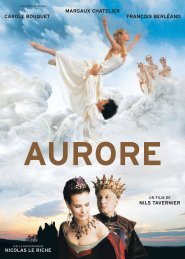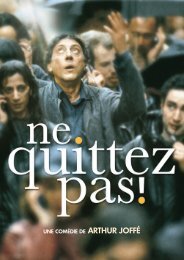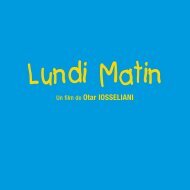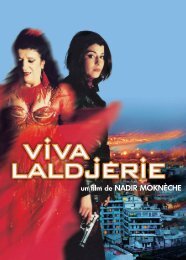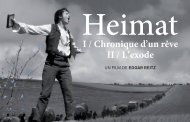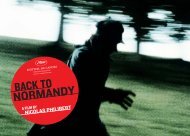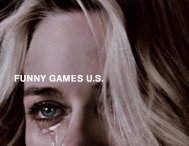chantrapas - Les Films du Losange
chantrapas - Les Films du Losange
chantrapas - Les Films du Losange
You also want an ePaper? Increase the reach of your titles
YUMPU automatically turns print PDFs into web optimized ePapers that Google loves.
CHANTRAPAS
PIERRE GRISE PRODUCTIONS presents<br />
CHANTRAPAS<br />
Press agent<br />
Magali Montet<br />
5 place d’Alleray - 75015 Paris (France)<br />
Tel.: +33 1 48 28 34 33 • Cell: +33 6 71 63 36 16<br />
magali@magalimontet.com<br />
A film by Otar IOSSELIANI<br />
International sales<br />
<strong>Les</strong> <strong>Films</strong> <strong>du</strong> <strong>Losange</strong><br />
Agathe Valentin / Lise Zipci<br />
22, rue Pierre 1 er de Serbie - 75116 Paris (France)<br />
a.valentin@films<strong>du</strong>losange.fr / Tel.: +33 1 44 43 87 28 • Cell : +33 6 89 85 96 95<br />
l.zipci@films<strong>du</strong>losange.fr / Tel.: +33 1 44 43 87 13 • Cell: +33 6 75 13 05 75<br />
Fax : +33 1 49 52 06 40<br />
www.films<strong>du</strong>losange.fr<br />
In Cannes<br />
Riviera booth F7<br />
FRANCE / GEORGIA • 2010 • 2h02 • Formats : 35mm – 1.66 / DOLBY SR
SYNOPSIS<br />
N<br />
icolas is an artist, a filmmaker, who asks for nothing<br />
more than to be able to express himself in freedom.<br />
Freedom that is the cause of many problems... From the start<br />
in Georgia, the “ideologues” wish to silence him, considering<br />
his work not in tune with the rules in place. Faced with their<br />
determination, Nicolas leaves his native country for France<br />
– land of freedom and democracy. But the “state of grace”<br />
will be short lived…<br />
CHANTRAPAS<br />
3
? INTERVIEW WITH OTAR IOSSELIANI<br />
■ Chantrapas ?<br />
Otar Iosseliani : It’s Russian, inspired by the<br />
French “chantera pas” (“won’t sing”). At the<br />
end of the XIXth century, the well-to-do families<br />
of Saint-Petersburg took their children to singing<br />
lessons with the Italian masters of bel canto. At<br />
the time, the Russian aristocracy spoke French,<br />
and hence the Italians learned two words, as<br />
they selected the children: “Chantera” (“Will<br />
sing”) and “Chantera pas” (“Won’t sing”).<br />
Later Chantrapas became a common word: the “<strong>chantrapas</strong>” were the<br />
“good for nothings”, the excluded… A bit like my main character, who is<br />
censored in the Soviet Union, and less well received than he expects in the<br />
West. Victor Hugo, Fritz Lang, René Clair, Orson Welles, Tarkovski, Askoldov,<br />
Chenguelaia… all were excluded, they were “Chantrapas”, forced to leave<br />
their native countries, not knowing very well how to swim in these unknown<br />
waters, each with an inner wound.<br />
■ Is this an autobiographical film?<br />
O.I. : No, as my fate was quite different. In the end, I always managed to<br />
do everything I wanted in the Soviet Union, even if my films were banned:<br />
Falling leaves, and all my short films. By the same token, if you were banned,<br />
you were someone who was respected. Then, in 1979, after Pastorale, I was<br />
forced to leave the country. Chantrapas is the portrait of a collection of filmmakers.<br />
Those of us who managed to overcome censorship, who may be<br />
counted on the fingers of the hand: Sergueï Paradjanov, Andrei Tarkovski,<br />
Georgui Chenguelaia, Gleb Panfilov, Alexandre Askoldov…<br />
During that time, 120 filmmakers worked for the<br />
regime, as cinema was an instrument of propaganda.<br />
Nevertheless, one cannot say that the censors were too<br />
severe. They banned the films, but they respected the<br />
filmmakers. It gave them headaches… They allowed us<br />
to finish the film, before banning it.<br />
■ One of the scenes ends on the censor holding his<br />
head in his hands.<br />
O.I. : Yes, he is suffering… They were just as oppressed<br />
by the system as we were. They could talk about your film in harsh terms,<br />
and, after informing you of the ban, come out and discretely shake your hand.<br />
■ The film begins with the screening of a short… one of your early<br />
works.<br />
O.I. : It was made a long time ago. I could have used a film of one of my<br />
colleagues, Chenguelaia or Tarkovski, one of their banned films in the Soviet<br />
Union, but there was a problem of copyright. I made this short film in 1959,<br />
and no one ever saw it.<br />
■ Could we speak of the numerous ellipses in the film?<br />
O.I. : In that respect, I’m not much of a filmmaker, rather, I put together a<br />
puzzle. To be understood, one must always take a step back and then a step<br />
forward. Here, I wanted it to be known that they were friends in childhood<br />
and remained friends as a<strong>du</strong>lts.<br />
I didn’t want to make a true historical reconstruction. In reality, the story<br />
of the film could not occur in less than ten years: the time for the film to be<br />
CHANTRAPAS<br />
5
children go to meet their friend, one hears arpeggios and ranges that stop<br />
when he appears at the window: one understands that he was playing.<br />
■ How would you define Chantrapas?<br />
O.I. : It is a parable on the need to remain true to oneself despite the<br />
obstacles that surround us. Which, a priori, condemns one to a fiasco. All the<br />
history of literature bares witness to this. Romeo and Juliet remained the<br />
same, but they died. That is what I wanted to share with the viewer: the joy<br />
of being a stone, resisting everything.<br />
■ It ends badly…<br />
O.I. : But everything ends badly in life!! Then again, perhaps the character<br />
will find happiness in the kingdom of the sirens…<br />
shot, banned, and for him to get the papers to leave the country… But I was<br />
intent on not having the character change. At no time did I want a linear<br />
construction with the style of the 50’s, 70’s, 80’s, 2000...<br />
From the beginning, it was one of the challenges of the project: to create<br />
a temporal construct that corresponds to what I usually do with space.<br />
It is very dangerous to make a film about the past. The period is not defined<br />
by the style of the clothes and the means of locomotion. It is a leap from one<br />
universe into another. Therefore, little matter over perishable historical<br />
elements…<br />
It is above all the periods in one’s memory, and memory compresses and<br />
mixes the elements…<br />
■ Bottles of wine, a man selling shoes, assistants who take pieces of<br />
the set before the scene is done… is it your vision of cinema?<br />
O.I. : Cinema is a charming fair. There’s everything: merchants, drinkers<br />
everywhere, serious people, functionaries. The filmmaker is in the middle, and<br />
everyone is having fun. Cinema, it’s a lot of fun.<br />
■ Music plays a crucial part in your films. Could we go over the musical<br />
choices in Chantrapas?<br />
O.I. : Music has always come from a real source in my films. I hate for it to<br />
be used as a crutch. I never use music to illustrate or transmit emotions to<br />
the viewer. The music is a character. When, in the beginning of the film, the<br />
6 CHANTRAPAS
■ In the editing room, what the old editor does, is it realistic?<br />
O.I. : Completely. Everyone, Dovjenko, Eisenstein, Poudovkine, they all edited<br />
like that: by hand. It’s a method: you pass the film quickly and you see the<br />
movement. I too, I worked that way when I didn’t have an editing table.<br />
Now there are computers everywhere, but it hasn’t made life easier. One<br />
makes dozens of versions, but there is no more time to think.<br />
A cut is a cut, no need to make 150 versions.<br />
■ How do you work with the actors?<br />
O.I. : When the crew arrives on the set, we all have – except for the actors<br />
- the story-board in hand. Every evening, we go over it, as it is what we will<br />
shoot and nothing else.<br />
The actors – who are not professionals – may not see it. Therefore, rehearsal<br />
time is often much longer than the actual shoot. It’s like choreography: the<br />
dialogues are of little importance; it’s the rhythm that counts.<br />
■ Is that the reason why you never have close ups or shot and reverse<br />
shots?<br />
O.I. : Never a close up: it destroys the character and brings forth the<br />
personality of the actor. The close up, shot and reverse shot, it’s shameful. In<br />
that case all you need to do is close your eyes and listen to the dialogues!<br />
One has to plan ahead if you want to play out the partition that you wrote.<br />
You were a composer, but on the set, you become a con<strong>du</strong>ctor. What is most<br />
exciting, in the artist’s craft, is the resistance of matter. The wardrobe master<br />
did not understand your instructions, you made mistakes in the casting, the<br />
locations betray you… You have to adapt your composition according to the<br />
number of orchestra instruments and the know how of the interpreters. Above<br />
all, you must not force them, which is the reason why I prefer not to work<br />
with famous actors. Even if I did work with Michel Piccoli and here, with Pierre<br />
Etaix and Bulle Ogier...<br />
■ Where did the idea to work with Pierre Etaix come from?<br />
O.I. : Because I like him very much, as a character, as a filmmaker, as a<br />
human being. I cannot work with pretentious people. With non-professionals,<br />
one avoids clichés, actors’ tics which they ceaselessly carry from one part to<br />
the next.<br />
■ You make an appearance in the film...<br />
O.I. : Oh, I never intended to play the part, but the actor we had chosen<br />
died just before shooting began. ■<br />
CHANTRAPAS<br />
9
CREW<br />
CAST<br />
Screenplay<br />
Director<br />
1st assistant Director<br />
Photography<br />
Sound<br />
Set Design<br />
Costumes<br />
Editing<br />
Sound Editing<br />
Music<br />
Mixing<br />
Story-board<br />
Photos<br />
Otar IOSSELIANI<br />
Otar IOSSELIANI<br />
Paolo TROTTA<br />
Lionel COUSIN (in Georgia)<br />
Julie GRÜNEBAUM (in France)<br />
Jérôme THIAULT<br />
Emmanuel de CHAUVIGNY<br />
Anna KALATOZISHVILI (in Georgia)<br />
Maïra RAMEDHAN-LEVI (in France)<br />
Otar IOSSELIANI, Emmanuelle LEGENDRE<br />
Georges-Henri MAUCHANT<br />
Djardji BALANTCHIVADZE<br />
Anne LE CAMPION<br />
Nana IOSSELIANI, Nougzar TARIELASHVILI<br />
Niko TARIELASHVILI<br />
Nicolas<br />
Barbara<br />
Fanny<br />
Grand father<br />
French pro<strong>du</strong>cer<br />
Catherine<br />
Ambassador<br />
Barbara’s husband<br />
Nicolas’ friend<br />
Grand mother<br />
The children<br />
Dato TARIELASHVILI<br />
Tamuna KARUMIDZE<br />
Fanny GONIN<br />
Givi SARCHIMELIDZE<br />
Pierre ETAIX<br />
Bulle OGIER<br />
Bogdan STUPKA<br />
Lasha SHEVARDNADZE<br />
Nika ENDELADZE MUSSELISHVILI<br />
Nino TCHKHEIDZE<br />
Nika BUTIKASHVILI<br />
Gela KATAMADZE<br />
Ana TARIELASHVILI<br />
Achiko IMERLISHVILI<br />
Pro<strong>du</strong>ced by<br />
A copro<strong>du</strong>ction<br />
and<br />
With the participation of<br />
of<br />
and<br />
In association with<br />
and<br />
Martine MARIGNAC<br />
PIERRE GRISE PRODUCTIONS (France)<br />
SANGUKO FILMS (Georgia)<br />
MINISTERE DE LA CULTURE<br />
CENTRE NATIONAL DE LA CINEMATOGRAPHIE (Georgia)<br />
SBERBANK<br />
ORANGE CINEMA SÉRIES<br />
CENTRE NATIONAL DE LA CINEMATOGRAPHIE (France)<br />
CINEMAGE 4<br />
COFINOVA 6<br />
PROGRAMME MEDIA PLUS DE LA COMMUNAUTE EUROPEENNE<br />
10 CHANTRAPAS<br />
CHANTRAPAS<br />
11
OTAR IOSSELIANI<br />
1959/65<br />
1962<br />
1964<br />
1966<br />
1970<br />
1976<br />
AT TBILISSI STUDIO<br />
Direction of 10 short-films<br />
April<br />
La Fonte<br />
The Fall of Leaves - International Critic’s Week - Cannes 1968 / Georges Sadoul Prize / Fipresci Prize<br />
Once a Black Bird - Best Foreign Film in Italy in 1974 / Directors’ Fortnight - Cannes 1974<br />
Pastorale - Fipresci Prize - Berlin 1981<br />
1982<br />
1983<br />
1984<br />
1988<br />
1989<br />
1992<br />
1994<br />
1996<br />
1998<br />
2001<br />
2006<br />
2010<br />
IN FRANCE<br />
7 Pieces for Black & White Cinema<br />
Euskadi - Directors’ Fortnight - Cannes 1983<br />
Favorites of the Moon - Special Jury Prize - Venice 1984<br />
The Small Monastery in Tuscany - Best Documentary Prize (Société des Gens de Lettres) 1989<br />
And Then There Was Light - Special Jury Prize - Venice 1989<br />
Chasing Butterflies - Grand Prize of the Academy of Arts in Berlin / Triomphe Prize 1993 (Best Foreign Work - Russia)<br />
Seule, Géorgie - Documentary for Arte<br />
Brigands, chapter VII - Special Jury Prize - Venice 1996 / Best acting at Dunkerque International Film Festival<br />
Home Sweet Home - Official Selection - Cannes 1999 / Louis Delluc Prize<br />
Monday Morning - Silver Bear for Best Director - Berlin 2002<br />
Gardens in Autumn - Official Selection – International Rome Film Festival 2006<br />
Chantrapas - Special Prize «Jean Vigo» for his life's work / Official Selection - Cannes 2010<br />
12 CHANTRAPAS<br />
CHANTRAPAS<br />
13
FB • Imprimerie Gestion Graphic 01 39 95 41 26



